Day 3 of a three day Late Autumn Tour. It was a much brighter day, with some sunny spells in the afternoon. A very blustery W wind in the morning eased gradually during the day.
With the wind forecast to go round to the WNW and gust up to 40mph this morning, we headed over to Sheringham first thing, where we could find a shelter on the seafront to get out of the wind and see what was passing over the sea. When we got down on the prom, it was very windy already, but perhaps with not as much north in it yet as forecast. A small group of people had already gathered at the shelter, so we joined them out of the wind.
There were a few Gannets passing offshore and we quickly picked up a some Little Gulls too. They were rather distant at first, but eventually one came in much closer where we could get a much clearer view of its black underwings. There were a few lingering terns again too – a couple of juvenile Arctic Terns flew past, the second accompanied by a juvenile Common Tern, so we could see the whiter trailing edge of the wing on the Arctic Tern. A small number of skuas flew past further out – 3 Arctic Skuas and a single Great Skua.
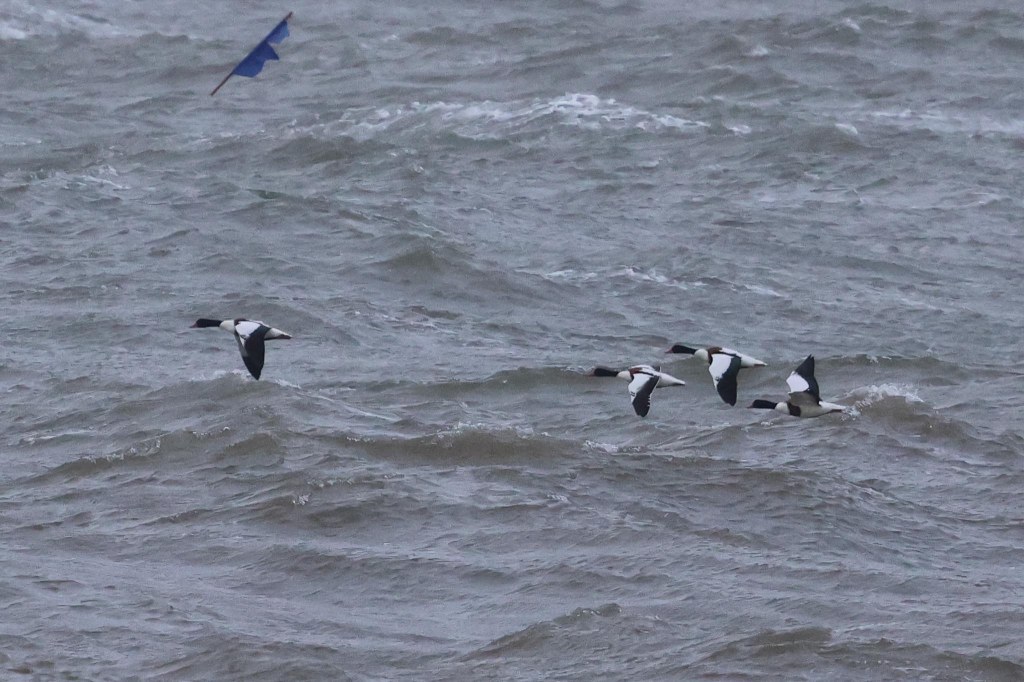
There was a nice selection of wildfowl moving this morning – small flocks of Wigeon and Teal, a few Brent Geese arriving from Siberia, and more Shelducks returning from their moult holiday on the Continent. Seaduck passing included a couple of Eider, a Red-breasted Merganser, a few Common Scoter and the highlight a single Velvet Scoter.
We saw a small number of waders coming in too – several Knot, a single Dunlin, and a couple of Common Snipe, one low over the waves, the second flying past high. Several Turnstones ran around on the prom in front of us, being buffeted by the wind – unfortunately we didn’t have any chips for them today! A small group of Starlings flew in off the sea and disappeared over the town.

The wind still didn’t seem to be going round, so we decided to look for a Purple Sandpiper. A small number spend the winter here, feeding on the sea defences, but speaking to the locals it sounds like just one is here so far, and it has been erratic in its appearances. We walked round to check their favourite spot in front of The Mo, but there was no sign of anything on the rocks. It felt like our luck as out. We started to walk back, and had just stopped to scan through the Turnstones on the shingle beach with the gulls, when the Purple Sandpiper flew in and landed in front of us.
It landed on a small bank in the shingle just in front of the breaking waves at first, and stood there preening. When a wave crashed over it, it jumped and ran up the beach, and started feeding on the tideline right below us. It was almost too close for photos! The Purple Sandpiper then flew up and landed on the edge of the prom with a couple of Turnstones and then ran up and down between us. Fantastic views.

Back to the minibus, we drove west to Wells. On the way, we slowed down to check the flood by the road at Stiffkey as we passed – there had been a Glossy Ibis out on the saltmarsh nearby a couple of days ago, and this has looked the perfect place for it to end up. There is nowhere to stop along here though, and we had a car behind us now, so we had to press on. It was only when we got to Wells that we got a message to say that the Glossy Ibis had just been found on the flood!
After a coffee break in the Beach Cafe, we walked up to the new Lifeboat Station. There has been a Black Redstart lingering here for the last few days and we quickly located it in the bushes just behind. It was getting chased continually by two Robins and kept disappearing into the bushes. From time to time it flew up and landed on the RNLI roof or the fence below. A Song Thrush, a couple of Blackbirds and two Dunnocks were in the bushes too, some of which were probably migrants freshly arrived from the Continent.

We then walked further round to see what we could find in the harbour. Immediately, we could see a Red-throated Diver just off the beach, and two Common Scoter just beyond. A couple of Common Seals bobbed up, daintier looking with a shorter nose than the Grey Seals we see more regularly.
Scanning further out, we found three Razorbills, two Great Crested Grebes, and three Shags. One of the Shags made its way in down the harbour and then swam right up to us on the shore, before turning back.
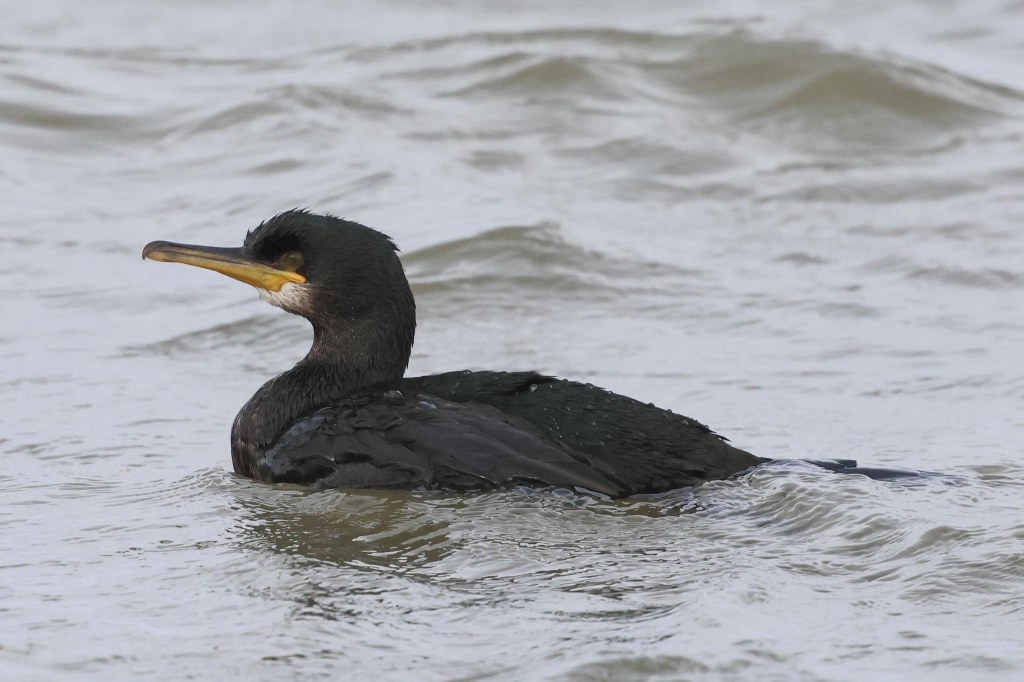
Then a Razorbill appeared in front of us chasing fish just off the beach, which in turn seem to attract the Red-throated Diver which surfaced right in front of us. Amazing views, so close to us. A second Red-throated Diver appeared in the boat harbour behind us, but dived and completely disappeared, presumably having resurfaced in amongst the boats.
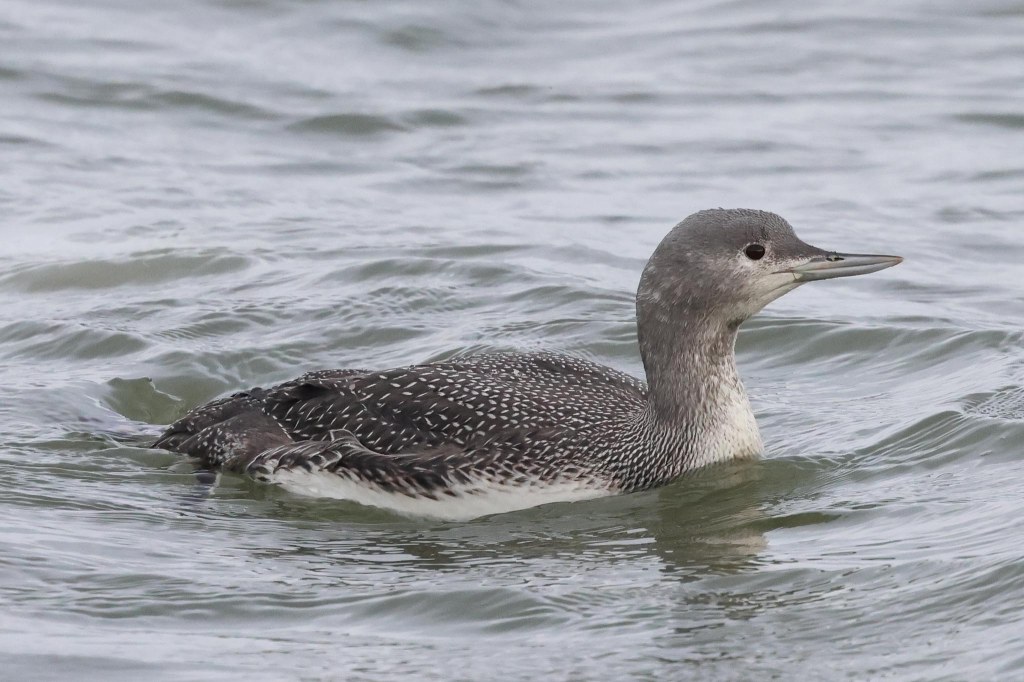
Across the harbour on the sand the other side we could see lots of waders. Some large groups of Oystercatcher and smaller numbers of Bar-tailed Godwit were roosting over high tide. A big flock of silvery grey Sanderling was catching the sunlight, and there were some smaller groups of Knot and a few Dunlin, Curlew and Redshank. Lots of Brent Geese were scattered around the edges of the harbour, and while we were looking through the waders we picked up a single Pale-bellied Brent among the commoner Dark-bellied Brents, a subspecies tick for the trip list. A flock of Starlings flew in from the direction of the sea.
It was time for lunch, so back at the cafe we sat down to eat on the picnic tables. Afterwards, we drove back to Stiffkey. This time we parked in the layby east of the flood and walked back down the permissive path to the north-east corner. The Glossy Ibis had apparently been down the far end with four Little Egrets, but we couldn’t see them initially. That was because they had been disturbed and the Glossy Ibis had flown down to the near end with a single Little Egret. Unfortunately, they were spooked again by something almost immediately and flew back down to the far end where they had been. It was rather distant and looking into the sun now, but we had clear views of the Glossy Ibis in the scopes, feeding in the flooded grass.
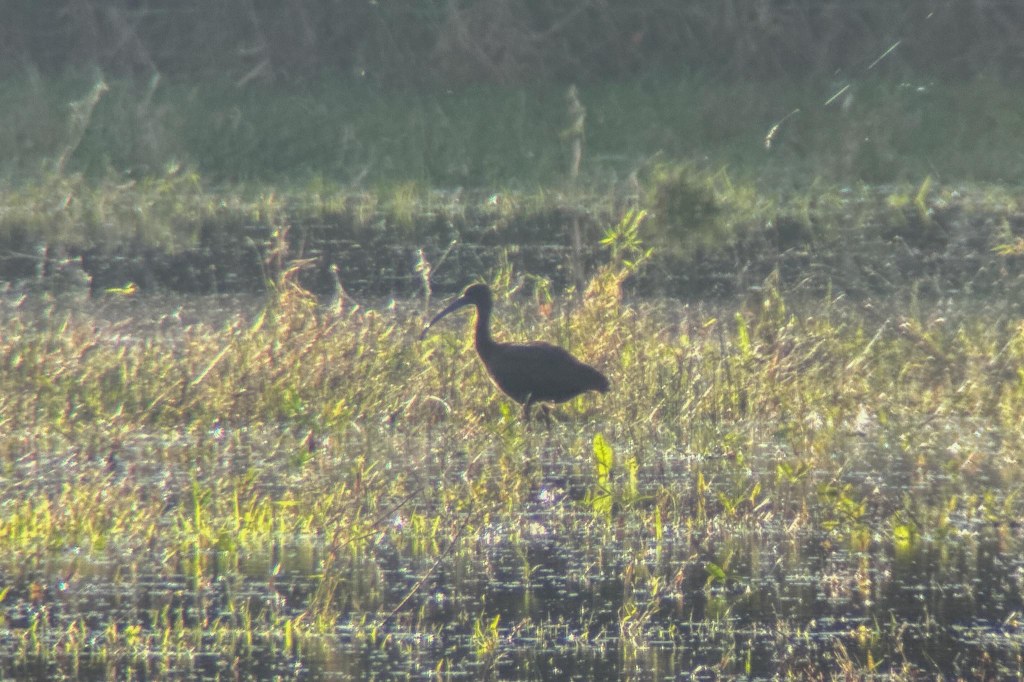
There were lots of ducks out in the middle too, Wigeon and Teal, and a small group of Greylag Geese. Several large skeins of Pink-footed Geese flew over calling. Three Red Kites circled up with a Common Buzzard over the wood beyond, in the sunshine. A couple of Stock Doves flew over and landed briefly in the wet grass.
We made our way back to Holkham next, and pulled up at the start of Lady Anne’s Drive, where several Cattle Egrets were feeding in with the cows right next to the road. More great views, we counted nine Cattle Egrets and at least four Grey Herons. We watched the Cattle Egrets catching frogs around the cows’ noses.
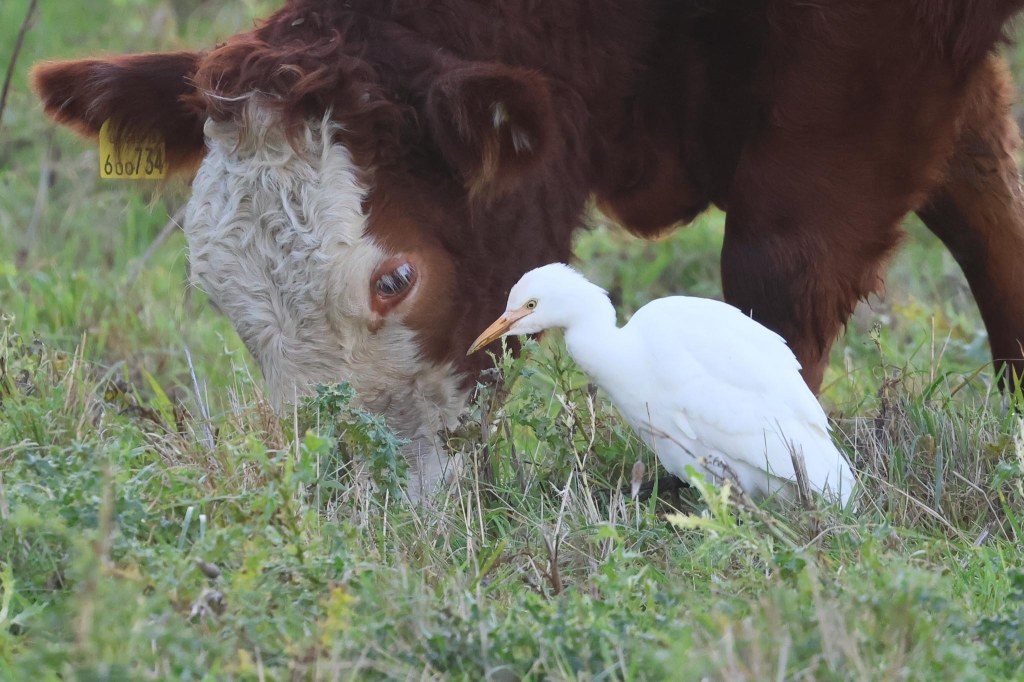
There were a few gulls around the flood in the field opposite, Common Gulls with the Black-headed Gulls. A pair of Egyptian Geese was out on the grass beyond. There was a small group of sheep out on here too, and then we noticed a striking silver-grey ‘Brown’ Hare feeding in between them. Also known as a ‘Blue’ or ‘Ghost’ Hare, it appears to be a rare colour mutation which produces a washed out grey coat. Several Red Kites and a Marsh Harrier drifted over.
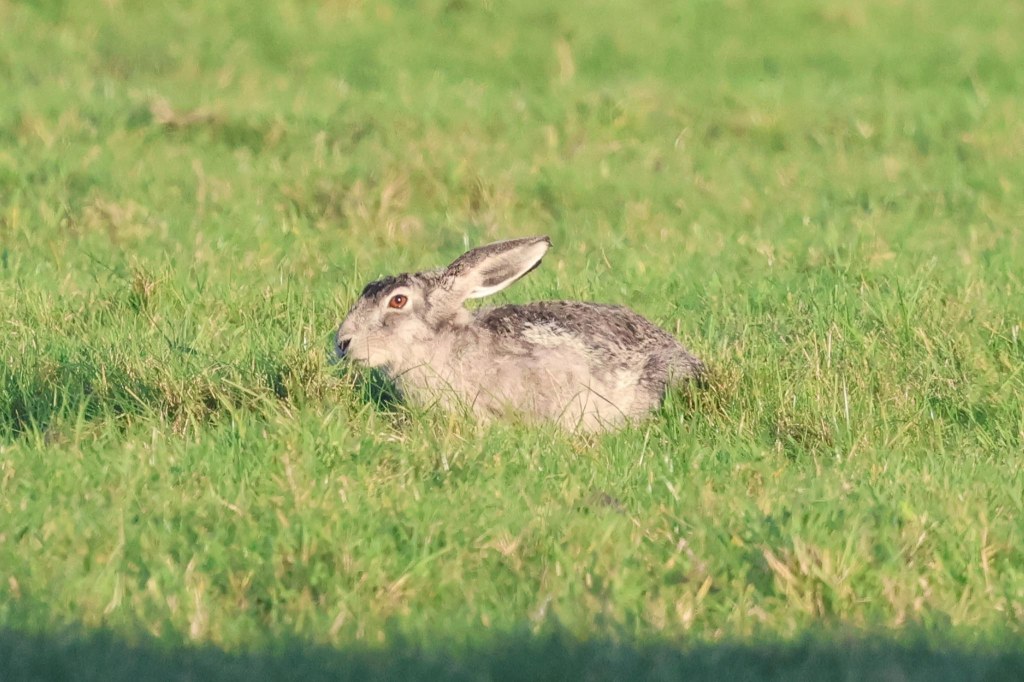
Continuing on down to the far end, we stopped to look at the grazing marshes. There are lots of Wigeon here now, as more birds have returned for the winter, along with smaller numbers of Teal, Mallard and several Gadwall. Some very large skeins of Pink-footed Geese flew up from further and disappeared off inland over the park. A Sparrowhawk perched on a post at the back of the grass showed nicely in the scopes. We were hoping to find the Grey Partridge here, but there was no sign again today. They have been very erratic so far this autumn, and hopefully they have not been disturbed by the building of a new bridle path for the car park right through their favoured feeding area!
As it was our last day, we had to be back promptly, so we decided to have a quick look at the grazing marshes at the west end of the pines. There were lots of geese out on the grass, mostly Greylags, but looking through we quickly found at least ten White-fronted Geese in with them. Lots of Cormorants were gathering to roost in the trees and lots of Lapwing were scattered around the pools. Several Chinese Water Deer were feeding in the grass.
A flock of Long-tailed Tits came down the hedge past us, and we found a single Goldcrest in with them. A Chaffinch and Siskin flew out from the tree above us. We were hoping we might find the lingering released White-tailed Eagle from the Isle of Wight here, but we couldn’t see it here now. There were mpre Red Kites and Marsh Harriers out over the marshes and then a young Peregrine flew in over the fields and off over the trees inland, a last addition to the trip list and one we had only a little earlier been discussing that we had not come across yet.
Light was already fading and it was time to call it a day. It had been an exciting and varied three days, with good birds and good company.













 Little Grebe – one of at least 17 on the boating lake today
Little Grebe – one of at least 17 on the boating lake today Treecreeper – flew in to the trunk of an old pine tree in front of us
Treecreeper – flew in to the trunk of an old pine tree in front of us Goldcrest – one of several feeding in the bushes round the drinking pool
Goldcrest – one of several feeding in the bushes round the drinking pool Black Redstart – on the roof of the warden’s house at Cley
Black Redstart – on the roof of the warden’s house at Cley Common Darter – basking in the sun along the boardwalk
Common Darter – basking in the sun along the boardwalk Little Stint – a juvenile, one of at least 7 on Simmond’s Scrape
Little Stint – a juvenile, one of at least 7 on Simmond’s Scrape Starling – feeding in the grass in front of the hide, a stunning bird close-up
Starling – feeding in the grass in front of the hide, a stunning bird close-up Avocet & friends – with a few Ruff and Black-headed Gulls
Avocet & friends – with a few Ruff and Black-headed Gulls Black Brant – with the Brent Geese in the Eye Field
Black Brant – with the Brent Geese in the Eye Field Spotted Redshanks – gave great close views after everyone else had gone
Spotted Redshanks – gave great close views after everyone else had gone Spoonbill – feeding in one of the channels in the harbour
Spoonbill – feeding in one of the channels in the harbour Spoonbill – taking off
Spoonbill – taking off

 Spoonbill – flew past on its way back
Spoonbill – flew past on its way back Black Redstart – a nice surprise in the dunes
Black Redstart – a nice surprise in the dunes Wheatear – a richly coloured male Greenland Wheatear
Wheatear – a richly coloured male Greenland Wheatear Wheatear – a very obliging female
Wheatear – a very obliging female Black Brant hybrid – still on the saltmarsh
Black Brant hybrid – still on the saltmarsh Sedge Warbler – there were lots singing at Snettisham today
Sedge Warbler – there were lots singing at Snettisham today Willow Warbler – singing from the trees
Willow Warbler – singing from the trees Chiffchaff – there were lots in the bushes
Chiffchaff – there were lots in the bushes Ring Ouzel – this female showed well today
Ring Ouzel – this female showed well today Redstart – this stunning male brightened up our morning
Redstart – this stunning male brightened up our morning Grasshopper Warbler – the fourth we heard perched up nicely
Grasshopper Warbler – the fourth we heard perched up nicely

 Waders – we were treated to a great display of a whirling flock
Waders – we were treated to a great display of a whirling flock Swallow – preening on the wires at Holme
Swallow – preening on the wires at Holme Black Redstart – a female in the paddocks at Holme
Black Redstart – a female in the paddocks at Holme Little Stint – still out on the Freshmarsh today
Little Stint – still out on the Freshmarsh today Avocet – trying to feed in the deep water
Avocet – trying to feed in the deep water Shelduck – a pair were in front of Parrinder Hide
Shelduck – a pair were in front of Parrinder Hide Gadwall – a pair of these too were in front of Parrinder Hide
Gadwall – a pair of these too were in front of Parrinder Hide Shoveler – several pairs were on the Freshmarsh
Shoveler – several pairs were on the Freshmarsh